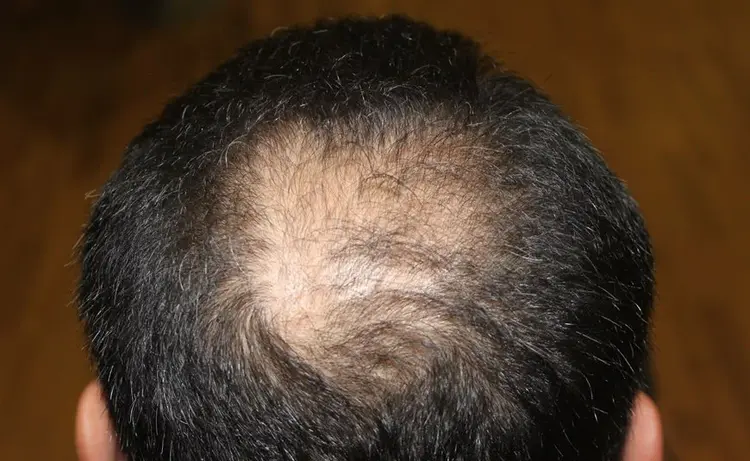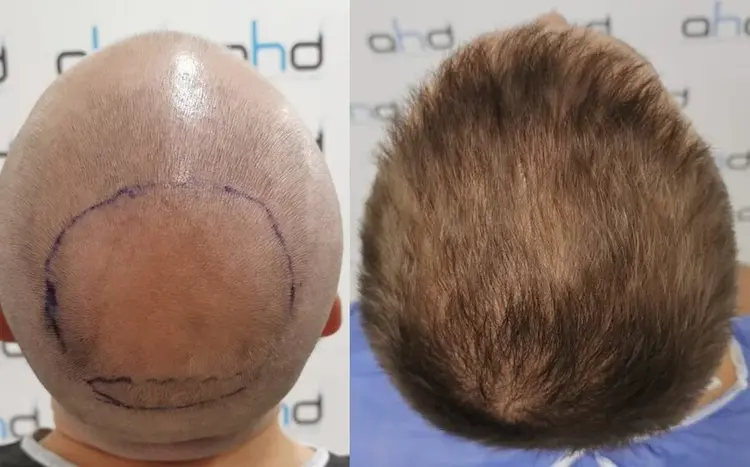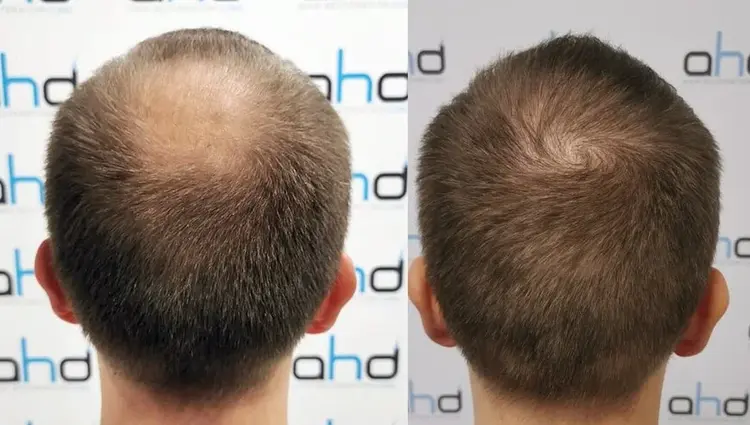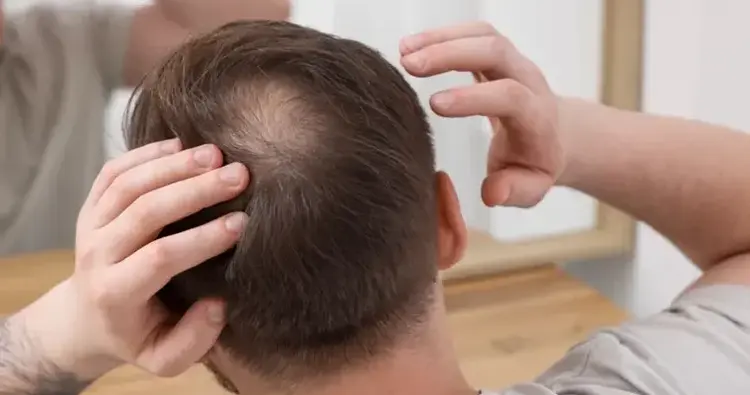Hair transplantation performed on the crown area differs from classical procedures due to certain characteristics such as angle differences. In this article, we will try to provide information about the causes of hair loss in the vertex region and its treatment methods
Why Does Hair on the Crown Area Fall Out?
n 70-80% of men, thinning and hair loss on the crown are observed at a certain stage of their lives. The most important reason for this is hormonal factors, namely androgenetic alopecia, also known as male pattern hair loss. In male pattern hair loss, the hair in this area is highly sensitive to the dihydrotestosterone (DHT) hormone. Consequently, the anagen (growth) phase of the hair shortens. Hair with a shortened anagen phase thins out prematurely and begins to sparse. In the early stages, this thinning may not be very noticeable. Thinning and sparseness are often more discernible when the hair is wet after a shower. In advanced stages, the thinned hair begins to fall out, leading to complete baldness.

Additionally, if there is a family history of hair loss in parents, it is highly likely that their children will experience the same condition. The rate of hair loss in the crown area is not the same for everyone. Generally, the pattern of hair loss seen in the father tends to continue similarly in his children.
According to the Norwood classification of hair loss, the crown area is also affected in Type 3 hair loss and above.
- Type 3: There is slight thinning/recession at the crown (vertex).
- Type 4: Baldness begins to increase in a circular pattern.
- Type 5: Complete baldness forms on the vertex. The hair loss continues to progress towards the front and back.
- Type 6 and 7: Baldness that covers the entire head has formed.
For those experiencing hair loss in the crown area, this does not necessarily mean that hair loss will occur over the entire scalp. In other words, not everyone with Type 3 and Type 4 hair loss will always progress to Type 5, 6, or 7.
What is Crown Area Hair Transplantation?
Crown area hair transplantation, also known as vertex transplantation, is the process of transferring strong hair grafts from the donor area to the thinning or balding area on the top of the head, known as the crown. The term “vertex,” which is of Latin origin, refers to the highest and topmost point of the head.
Who is a Suitable Candidate for Crown (Vertex) Hair Transplantation?
For a crown hair transplant, the hair in the donor area must be strong and sufficient in number. The most suitable candidates are those who experience hair loss only on the top of the head and have strong donor hair.
In cases of extensive baldness like Type 6-7, the donor hair will likely be insufficient for full coverage. In this situation, a crown transplant is not very logical. This is because, for the vast majority of people experiencing hair loss, the most important areas are the frontal hairline and the frontal region. When hair transplanted to the front and top areas is combed back, it can also camouflage the empty areas at the back.
Vertex Hair Transplant Stages
Apart from a few points that require attention, transplantation to the crown (vertex) area is no different from a classic hair transplant procedure. This operation is completed in 3 stages.
1) Consultation and Pre-Operative Period: First, it must be confirmed whether the person is suitable for this operation. Your doctor will examine the quality and capacity of the hair in your donor area. As we mentioned before, a hair transplant may not be the right choice for advanced degrees of baldness, such as Norwood 6-7. For suitable candidates, an IV line is established, and the donor area is shaved to prepare you for the operation.
2) Extraction of Grafts from the Donor Area: The primary preference for the donor area is the strong hair in the occipital region (back of the head) between the two ears. After the donor area is shaved, local anesthesia is applied. Following anesthesia, the hairs are carefully extracted one by one using the FUE method.
In case of donor area insufficiency, beard and chest hair can also be used for crown transplantation.
3) Crown Hair Transplantation: Local anesthesia is applied to the recipient area where the transplantation will take place, and the collected grafts are placed one by one into the planned area. Minimally invasive methods such as FUE or DHI are used for the transplantation of the hair. At AHD Clinic, we prefer the DHI hair transplant technique for this operation. The duration of the operation varies depending on the number of grafts to be transplanted and can take an average of 4-7 hours.

Important Considerations for Crown Hair Transplantation
- Crown hair has its own unique angles. This hair grows in a circular, whorl-like pattern. In fact, some individuals may even have two distinct spirals. Within this hair whorl, the angles change 360 degrees from top to bottom, meaning the hair fans out to the right and left. During the transplantation, the channels must be opened parallel to the direction of the native hair in this area. Otherwise, a natural appearance cannot be achieved. For this reason, crown hair transplantation is difficult, and choosing a proven, qualified doctor is crucial, as opening channels at the correct angles requires expertise.
- The direction of the hair just above the donor area (occipital protuberance) points downward. Therefore, when transplanting the crown, the patient must lie face down. This position makes it easier to place the grafts at the correct angles.
- Furthermore, the scalp thickness in the crown region is greater than in the frontal area. When opening channels, depth control must be planned correctly. The angles of the opened channels should be 20-25 degrees relative to the scalp. If channels are opened at steeper angles, a natural and dense appearance may not be achieved.
- The correct angles mentioned above are more easily created with the pens (called implanter pens) used in the DHI method. Therefore, AHD Clinic prefers the DHI method for hair transplants. Additionally, performing a shaveless transplant with the pen method is easier in this area. In fact, during a shaveless FUE procedure, implanting parallel to the person’s existing hair will be easier.
- If beard and nape hair are to be used together, implanting these grafts in a mixed fashion will create a more natural look.
The Recovery Process
The post-operative experience is almost identical to that of classic hair transplantation. Redness and scabbing after the procedure will disappear with washing within at most 10 days.
In cases where transplantation is performed only on the crown (vertex), there may be no swelling at all after the procedure. This is because the fluid administered into the scalp will flow downward toward the nape, preventing significant facial swelling. The recovery process is generally completed within 1 to 10 days.
Typically, the transplanted hair will begin to shed after 15-20 days. In hair transplantation performed on this area, the rate of shock loss may be relatively higher. This is due to the fact that blood circulation in the crown region is less compared to the front.
Results of Crown (Vertex) Hair Transplantation
After shock loss, the shed hair in the crown region will regrow later compared to the hair transplanted in the front. Generally, you can start seeing new hair growth from the 4th-5th month onward. By the end of the 6th month, an average of 50% hair growth is normal. To achieve full results in the vertex area, it usually takes 15-18 months. In other words, compared to the hair transplanted in the front, the full results for the crown may take an additional 2-3 months.

What is the Success Rate of Hair Transplantation in the Crown Area?
rown transplantation is more difficult than the frontal hairline for the reasons mentioned above. Due to the unique angles of the vertex (crown), more grafts will be needed to achieve good density. For this reason, a second session may be required to provide better coverage.
However, if the number of grafts to be placed per square centimeter is planned correctly, the success rate of crown hair transplantation will also increase. Good coverage in the crown area can be achieved with an average of 45-50 grafts per cm². Additionally, the thickness and structure of the hair shaft are important factors in coverage. For example, a more successful appearance can be achieved in the crown for those with wavy hair structure.
In transplantations performed on both the frontal and crown areas, the majority of the grafts are usually implanted into the frontal hairline and the area behind it. This is because most people primarily want their frontal area to be covered. Consequently, the number of grafts allocated to the crown remains low. In this case, a sparser appearance occurs in the crown compared to the frontal area. Of course, since a period like 1 year has passed, it is often thought that the hair in this area has not grown. This is actually not true. The reality is that enough grafts were not implanted into the crown to achieve full coverage.
Choosing the right doctor is also very important to achieve successful results in the crown area. For this, examine the before-and-after hair transplant results of the clinic you are considering. If available, review recommendations and complaints about them. It is particularly beneficial to look at reviews about the doctor and clinic on forum sites before making your decision, as the comments people share on forums are usually realistic and unbiased.
Cost of Crown Hair Transplantation
Operation costs will vary depending on the number of grafts. Furthermore, costs also change depending on whether the FUE or DHI method is used. The fees of qualified hair transplant surgeons are always higher.
In Turkey, you can have a hair transplant in the crown area for an average price range of 1,500 – 5,000 USD. In the United States, crown hair transplant prices typically range from 5,000 – 15,000 USD. Our clinic does not have a separate pricing practice for crown hair transplants.
Frequently Asked Questions
How many grafts are needed for crown hair transplant?
Hair loss in the crown area is usually circular. Before the hair transplant, the size of the circular area is determined using the (Pi*r²) formula. Based on this size, the number of grafts to be taken from the donor area is calculated. Depending on the size of the circular area, the number of grafts required can vary between 1,000 and 3,000. For individuals at the Norwood 4-5 stage, 2000 grafts to the crown will usually be sufficient.
What is the ideal age for a crown hair transplant?
The rate of hair loss and the person’s age are significant factors in vertex (crown) hair transplantation. Having a crown transplant at a young age is not very logical because the likelihood of hair loss continuing in the coming years is high, and the person may not have enough donor hair left for the frontal area. Therefore, individuals aged 35-40 and over are the most ideal candidates for crown hair transplantation. Depending on your donor area capacity, your age, and your rate of hair loss, you should have realistic expectations regarding the crown.
Is it necessary to shave the hair for a crown hair transplant?
If the hair transplant is to be performed using the DHI (Direct Hair Implantation) pen technique, it is not necessary to shave the crown hair. In fact, a shaveless transplant can be more advantageous because it is easier to implant at angles parallel to the person’s existing hair this way.
If only the vertex area has been transplanted, what should the sleeping position be?
In this case, sleeping on your side is the most ideal solution. Sleeping in an elevated position with two pillows can prevent damage to the hair while sleeping.
My Crown is Thinning, What Should I Do?
In cases of crown hair loss, if you are a suitable candidate for a hair transplant, your chances of getting a successful result are high. For this, you will need to consult a proven hair transplant surgeon or a dermatology specialist. Additionally, medical treatments such as Finasteride, Minoxidil, and PRP will positively contribute to both the hair loss problem and the result of the hair transplant after the operation. However, remember that such medical treatments are only effective while they are being used. When you stop the medication, the situation will revert to what it was before. In cases of sparse hair growth due to graft deficiency, SMP (scalp micro pigmentation) can be considered as an alternative solution for increasing density.
Schedule a consultation with the AHD clinic.
Personalized solutions can be developed at Turkey’s most prestigious clinic
If you are considering a hair transplant in Turkey, schedule a free consultation with AHD clinic and get information about our prices. AHD clinic’s before and after results will give you a realistic idea.

